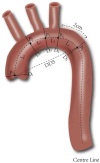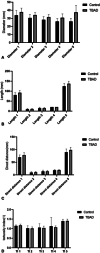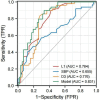Computed Tomography Scan of the Aorta to Predict Type B Aortic Dissection
- PMID: 37137329
- PMCID: PMC10914493
- DOI: 10.1055/s-0043-57026
Computed Tomography Scan of the Aorta to Predict Type B Aortic Dissection
Abstract
Background: The purpose of this study is to find the high-risk morphological features in type B aortic dissection (TBAD) population and to establish an early detection model.
Methods: From June 2018 to February 2022, 234 patients came to our hospital because of chest pain. After examination and definite diagnosis, we excluded people with previous cardiovascular surgery history, connective tissue disease, aortic arch variation, valve malformation, and traumatic dissection. Finally, we included 49 patients in the TBAD group and 57 in the control group. The imaging data were retrospectively analyzed by Endosize (Therevna 3.1.40) software. The aortic morphological parameters mainly include diameter, length, direct distance, and tortuosity index. Multivariable logistic regression models were performed and systolic blood pressure (SBP), aortic diameter at the left common carotid artery (D3), and length of ascending aorta (L1) were chosen to build a model. The predictive capacity of the models was evaluated through the receiver operating characteristic (ROC) curve analysis.
Results: The diameters in the ascending aorta and aortic arch are larger in the TBAD group (33.9 ± 5.9 vs. 37.8 ± 4.9 mm, p < 0.001; 28.2 ± 3.9 vs. 31.7 ± 3.0 mm, p < 0.001). The ascending aorta was significantly longer in the TBAD group (80.3 ± 11.7 vs. 92.3 ± 10.6 mm, p < 0.001). Besides, the direct distance and tortuosity index of the ascending aorta in the TBAD group increased significantly (69.8 ± 9.0 vs. 78.7 ± 8.8 mm, p < 0.001; 1.15 ± 0.05 vs. 1.17 ± 0.06, p < 0.05). Multivariable models demonstrated that SBP, aortic diameter at the left common carotid artery (D3), and length of ascending aorta (L1) were independent predictors of TBAD occurrence. Based on the ROC analysis, area under the ROC curve of the risk prediction models was 0.831.
Conclusion: Morphological characteristic including diameter of total aorta, length of ascending aorta, direct distance of ascending aorta, and tortuosity index of ascending aorta are valuable geometric risk factors. Our model shows a good performance in predicting the incidence of TBAD.
The Author(s). This is an open access article published by Thieme under the terms of the Creative Commons Attribution-NonDerivative-NonCommercial License, permitting copying and reproduction so long as the original work is given appropriate credit. Contents may not be used for commercial purposes, or adapted, remixed, transformed or built upon. (https://creativecommons.org/licenses/by-nc-nd/4.0/).
Conflict of interest statement
None declared.
Figures





Similar articles
-
TEVAR for complicated and uncomplicated type B aortic dissection-Systematic review and meta-analysis.J Card Surg. 2021 Oct;36(10):3820-3830. doi: 10.1111/jocs.15827. Epub 2021 Jul 26. J Card Surg. 2021. PMID: 34310731
-
The Role of Location, Length, and Thickness of the Intimal Flap in the Propagation of Stanford Type B Aortic Dissection Based on Ex Vivo Porcine Aorta Models.J Endovasc Ther. 2025 Aug;32(4):1214-1223. doi: 10.1177/15266028231199930. Epub 2023 Sep 20. J Endovasc Ther. 2025. PMID: 37728019
-
Early Thoracic Endovascular Aortic Repair for Acute Type B Dissection Is Associated with Increased Complications: Results from the Gore Global Registry for Endovascular Aortic Treatment Registry.Ann Vasc Surg. 2025 Sep;118:1-10. doi: 10.1016/j.avsg.2025.03.020. Epub 2025 Apr 13. Ann Vasc Surg. 2025. PMID: 40233894
-
Assessment of aortic arch involvement in ascending thoracic aortic aneurysm by three-dimensional growth mapping using CT-angiography.Eur Radiol. 2025 Jun;35(6):3508-3518. doi: 10.1007/s00330-024-11239-9. Epub 2024 Nov 30. Eur Radiol. 2025. PMID: 39616281
-
Aneurysmal degeneration of type B aortic dissections after thoracic endovascular aortic repair: A systematic review.J Vasc Surg. 2017 Sep;66(3):924-930. doi: 10.1016/j.jvs.2017.06.067. Epub 2017 Jul 21. J Vasc Surg. 2017. PMID: 28736120
References
-
- Vilacosta I, San Román J A, di Bartolomeo R et al.Acute aortic syndrome revisited: JACC state-of-the-art review. J Am Coll Cardiol. 2021;78(21):2106–2125. - PubMed
-
- Lombardi J V, Hughes G C, Appoo J J et al.Society for Vascular Surgery (SVS) and Society of Thoracic Surgeons (STS) reporting standards for type B aortic dissections. J Vasc Surg. 2020;71(03):723–747. - PubMed
-
- Alberta H B, Takayama T, Smits T C et al.Aortic arch morphology and aortic length in patients with dissection, traumatic, and aneurysmal disease. Eur J Vasc Endovasc Surg. 2015;50(06):754–760. - PubMed
-
- Poullis M. Aortic length and curvature and risk of aortic dissection. J Cardiovasc Surg (Torino) 2021;62(04):410. - PubMed
-
- Krüger T, Sandoval Boburg R, Lescan M et al.Aortic elongation in aortic aneurysm and dissection: the Tübingen Aortic Pathoanatomy (TAIPAN) project. Eur J Cardiothorac Surg. 2018;54(01):26–33. - PubMed

